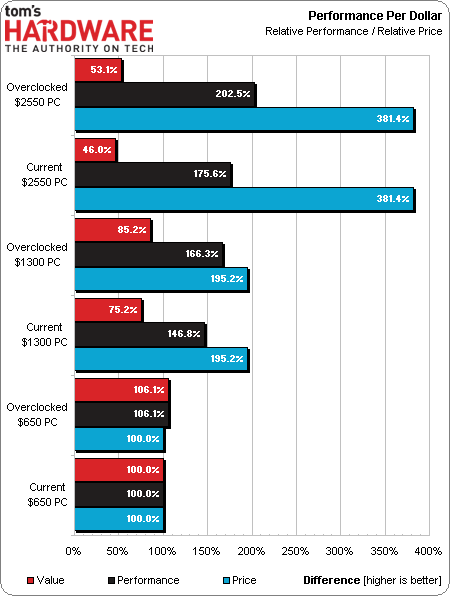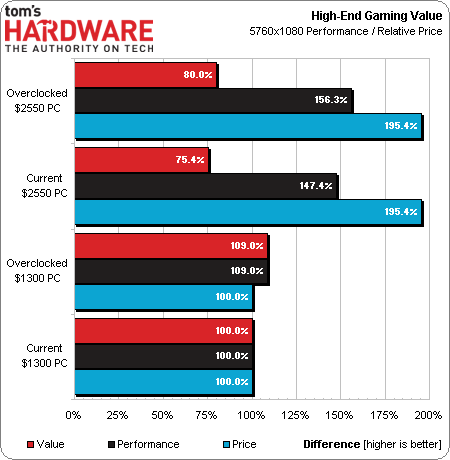System Builder Marathon: Performance And Value Compared
Does Paul, Don, Or Thomas Win This Round?
I spent much of this comparison discussing Don’s $1300 machine from the perspective of a $2550 machine builder, but value is the place for Paul's $650 machine to shine. After all, its small budget bought him enough power to cruise through all of our benchmarks except one, and its one failure was in a gaming test set to Ultra quality (even after it already proved its mettle at High quality settings).
When four times the budget buys two times the performance, big spenders have a value problem. A mere doubling of Paul’s $650 budget scored Don’s $1300 machine less than a 50% performance improvement, though Don’s overclocking gains were far greater. The general trend in this System Builder Marathon is that every dollar spent on upgrades yields $.50 worth of performance improvements.
But Paul’s machine didn’t even get tested at our highest gaming resolution, and we saw a few places where it probably wouldn’t have passed. Affluent builders usually put their money towards professional or gaming apps, and gaming is the easier place to blow cash.
Even when we narrow our criteria down to the task on which a third of the $2550 machine’s budget was spent, we see that every extra dollar returns $.50 in improved performance. For the benefit of this chart, perhaps a truly extreme gaming build is in order for our next competition?
On the other hand, nearly a quarter of the $2550 machine’s budget was spent on the Sandy Bridge-E CPU. If your work relies on compute time, you can calculate performance in terms of man hours (rather than the cost of your system), and man hours are typically far more valuable. The $2550 machine isn’t a purpose-built workstation, but some builders might use it that way, and all of them would have chided us if we hadn't use one of Intel's fastest CPUs. And though our productivity suite isn’t optimized for GPU-based computing, we’re sure a few of our readers are itching to discuss its possibilities.
Apart from those special circumstances, Paul’s $650 is the true value leader. The most frugal among us might consider anything costlier an exuberant celebration of waste, while the enthusiasts could very well feel justified spending more for diminishing returns in performance.
Current page: Does Paul, Don, Or Thomas Win This Round?
Prev Page Average Performance And EfficiencyGet Tom's Hardware's best news and in-depth reviews, straight to your inbox.
-
ryude Value is one thing, but when it comes to gaming you have to build for a minimum acceptable framerate and graphical fidelity. Once you factor those in you see that the $1300 build is indeed the value leader. The $650 build cannot play all games at 1080p60, high settings, and decent AA.Reply -
itzsnypah It always seems that to be the best value in SBM you need the cheapest case, psu and motherboard and spend as much as you can on graphics.Reply -
Martell1977 So at what price point does diminishing returns really kick in, approximately? Would spending a little more on the GPU for the $650 still be a solid value add?Reply
Basically, at what point between $650 and $1300 does the price/performance ratio seriously diminish? -
Crashman Reply
That doesn't stop me from setting a minimum quality standard for the high-end build, that comes at a higher price than the minimum performance standard. And, it doesn't stop me from adding a secondary storage drive, because these are things that the owner of this system would expect to have. I go into this knowing that I'm "wasting" money on quality, features and convenience items, and it doesn't bother me at all :)11603306 said:It always seems that to be the best value in SBM you need the cheapest case, psu and motherboard and spend as much as you can on graphics.
One of our SBM's focused on that question. It's currently somewhere around $700.11603341 said:So at what price point does diminishing returns really kick in, approximately? Would spending a little more on the GPU for the $650 still be a solid value add?
Basically, at what point between $650 and $1300 does the price/performance ratio seriously diminish?
-
ingtar33 Reply11603258 said:Value is one thing, but when it comes to gaming you have to build for a minimum acceptable framerate and graphical fidelity. Once you factor those in you see that the $1300 build is indeed the value leader. The $650 build cannot play all games at 1080p60, high settings, and decent AA.
you didn't bother reading the benching at all apparently. The 650 build was way over 60fps in all titles on ultra settings at 1080p except for far cry (it was even over 60fps on skyrim, which really hates amd cpus). Far Cry 3 has always been a gpu melter in the category of crysis 3; so it shouldn't be surprising a 760gtx can't max fc3 on ultra at 1080p. It doesn't in any other bench anywhere either. And fc3 was clearly playable on ultra at 1080p (30-40fps). Personally if i built a $650 machine and it killed every game i threw at it at 1080p and 60fps i'd call it a day. there really isn't a reason to spend more on your hardware unless you're going to spend a fortune on better/multiple monitors with bigger resolutions...
Computer tech has come a long way, that we basically have a mainstream gaming platform at 1080p for $650 is a great thing. -
nerrawg Reply11603258 said:Value is one thing, but when it comes to gaming you have to build for a minimum acceptable framerate and graphical fidelity. Once you factor those in you see that the $1300 build is indeed the value leader. The $650 build cannot play all games at 1080p60, high settings, and decent AA.
Actually what you realise is that the CPU on the $650 build is probably good enough for a GTX 780/AMD7970 or 2 GTX 760's in SLI. With that added expenditure of only $150-300 you could play anything you want to at 1080p without the PC breaking a sweat. It goes to show that, while the AMD Piledrivers are far behind intel's quad core K series, they can still represent decent value for a gaming PC. Nice article. -
m32 ingtar33, I agree with you. In the coming months your $650 is going to get you more with AMD's 7000 series price dropping. More money is great if you got it. Get your Titans if you can! Average folks are going to be sticking to the sub $850 range.Reply -
icerider Great SBM guys. Would have preferred to see the $650 machine get this,Reply
GIGABYTE GV-R795WF3-3GD Radeon HD 7950 3GB for $224 ($199 after rebate)
and spent the additional money on a ,
COOLER MASTER Hyper 212 Plus
which gives plenty of headroom to take a fx-6300 to an easy 4.5 ghz OC with low temps. Just built my first 2 FX-6300s this way with absolutely no problem.
With an extra Gig of graphics memory, comparable gpu oc ability and framerates and a solid OC on the cpu I think this system would be an easy walk away winner. -
bemused_fred OK, OK, OK. Could someone please explain why there are benchmarks in this at all? Does anyone ever expect the $650 PC to come near the $1300 and $2550 ones withs superior hardware? It's a complete waste of time to make those graphs, because a 5-year-old can probably tell you what the results will be: the more expensive stuff gets you better performance.Reply



